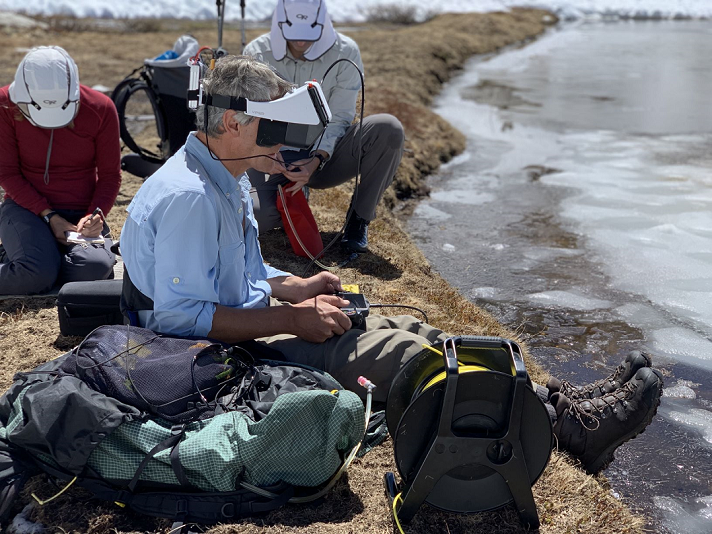2022 MLRG Annual Wrap-up and Newsletter
Our annual newsletter highlights our 2022 accomplishments in frog recovery, disease ecology research, and mentoring of next-generation scientists! This year, our newsletter shares their voices and views on working in wilderness, learning research skills, and being part of an ongoing conservation project. In short, it takes a village. You can learn how we fund mountain-yellow legged frog recovery, and how you can help (like donating your used smartphone!). A big thank you to our hard-working technicians, the staff at UC Santa Barbara Earth Research Institute and the Sierra Nevada Aquatic Research Lab, and all of our agency partners in frog conservation for a successful season!
<click here to read the newsletter>

Photo credit: Sara Dykman 2022
2022 Publications
Here are some of the papers that MLRG members contributed to in 2022:
[PDF] Host density has limited effects on pathogen invasion, disease-induced declines, and within-host infection dynamics across a landscape of disease. Journal of Animal Ecology.
Wilber, M. Q., R. A. Knapp, T. C. Smith, and C. J. Briggs.
[PDF] Rana sierrae (Sierra Nevada Yellow-legged Frog). Behavior and Diet. Herpetological Review. Smith, T. C., R. A. Knapp, J. Imperato, K. Miller, and D. Rose.
[link] Effectiveness of antifungal treatments during chytridiomycosis epizootics in populations of an endangered frog. PeerJ. Knapp, R. A., M. B. Joseph, T. C. Smith, E. E. Hegeman, V. T. Vredenburg, J. E. Erdman Jr, D. M. Boiano, A. J. Jani, and C. J. Briggs.
[PDF] Localized carry‐over effects of pond drying on survival, growth, and pathogen defenses in amphibians. Ecosphere. Le Sage, E.H., Ohmer, M.E., LaBumbard, B.C., Altman, K.A., Reinert, L.K., Bednark, J.G., Bletz, M.C., Inman, B., Lindauer, A., McDonnell, N.B., Parker, S.K. Skerlac S.M., Wantman, T., Rollins-Smith, L.A., Woodhams, D.C., Voyles, J., and Richards-Zawacki, C.L.
Mountain yellow-legged frog restoration amid a wildlife pandemic.
California’s mountain yellow-legged frogs are endangered. One reason is an ongoing wildlife pandemic (or, a panzootic). Worldwide, amphibians are threatened by a disease called chytridiomycosis, caused by the amphibian chytrid fungus Batrachochytrium dendrobatidis. This disease has caused declines in frog and salamander species across six continents, including here in California. In a public seminar on Thursday 12 November 2020, our own Mountain Lakes Research Group Principal Investigator Tom Smith, PhD described some of the conservation tools that we study. Our goal is to help mountain yellow-legged frog populations persist in a landscape with widespread disease.
The recorded seminar is available to watch:
https://www.youtube.com/channel/UCRKf_rnxbSEvv_dp5lZtPBQ
This seminar was part of the UC Santa Barbara Natural Reserve System seminar series. Our research group is based out of the Sierra Nevada Aquatic Research Laboratory, which is part of the Natural Reserve System.
Technology aids conservation: Observing frog behavior in frozen lakes using ROVs.
“What do frogs do in winter?” That is a question we hear frequently. Meters-thick ice covers high elevation Sierra Nevada lakes for about nine months of the year. For an animal that spends summer days lounging on rocks in the sun, winter imposes a radical shift in lifestyle. But historically, we could not document frog winter behavior through direct observation. Although scuba diving allows observation of some taxa, winter ice, elevation, and remoteness prevent us from diving in Sierra lakes.
Enter David Lang and his team, who developed the Trident underwater drone at OpenROV and Sofar Ocean Technologies. Over the past few years, our team used a Trident to search for frogs in a frozen lake. This technology allowed us to find frogs and tadpoles, and to capture video to document their overwintering behavior. David and some of his colleagues joined us at our study lake on two late winter expeditions and experienced our “eureka” moments in which we saw frogs and tadpoles as never before. Through the lens of the Trident and the VR goggles, we finally saw the frog’s eye view of life under the ice.
In his recent OneZero article, David describes how the Trident makes this project possible. More generally, he explores the potential for tech to enhance conservation projects. We are happy to see David’s story published, and honored that he focused on our project. Read his story here.

2018 Mountain Lakes Research Group newsletter
We recently sent out our annual Mountain Lakes Research Group newsletter in which we summarize the highlights from our our research and conservation-related activities in 2018. We also discuss the funding challenges that we face, exacerbated by the prolonged shutdown of the federal government, and our fundraising plans for the future. If you would like to receive future newsletters, please let us know.
Story on how scientists transport animals
The Conversation recently published a story about how scientists move butterflies, sea turtles, and frogs as part of conservation-related activities. The section on frogs features mountain yellow-legged frogs and was written by Mountain Lakes Research Group team member, Roland Knapp. Have a look.
